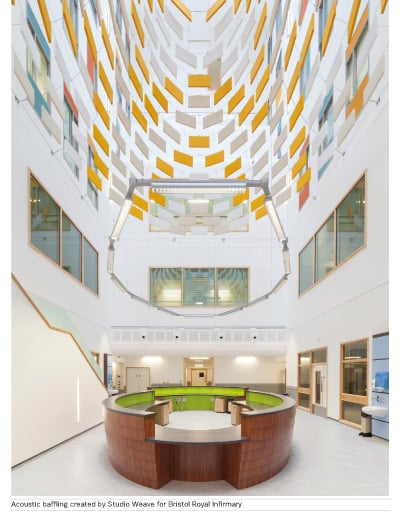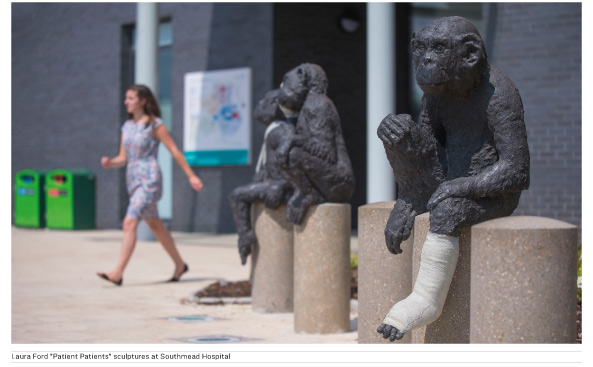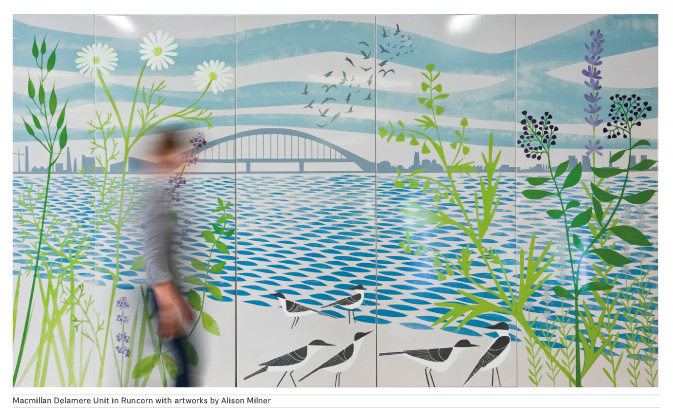HealthManagement, Volume 16 - Issue 4, 2016
Summary
What are the benefits of including art in healthcare settings? Willis Newson have over 15 years’ experience of working with healthcare partners to deliver creative solutions to problems and to integrate art into environments. We have worked across different spaces, from accident and emergency (A&E) to wards, mental health units to care homes, using art to engage patients, improve wayfinding, boost wellbeing and more. We conclude that working with artists helps to humanise the healthcare experience for patients, resulting in less stress and anxiety and positive perceptions of the care received.
Context
Since we were established in 2001 we have delivered over 200 projects for more than 31 national health service (NHS ) t rusts a nd a rchitects, d evelopers, c ontractors, government and arts partners.
This article will focus on a selection of case studies illustrating different approaches to arts and health projects.
Arts and health as a sector has now been established for over 20 years and is becoming more and more widely recognised as a force for good within the healthcare industry.
It can be beneficial in many different ways, from finding creative
solutions to practical problems such as noise reduction to ‘softer’ outcomes
such as improved sense of wellbeing or increased positivity.
See Also: Zoom On: Samuel Brown, Director, Center for Humanizing Critical Care
Here we have chosen 10 real-life examples of the beneficial effects
of including art in healthcare environments:
Welcoming
Southmead Hospital Bristol wanted to create the right first impression with patients, so we commissioned sculptor Laura Ford to create landmark artworks across the hospital site.
Her series of playful animal sculptures are already firm favourites with patients visiting the new hospital, who sent in hundreds of suggestions of names for the lion sculpture within days of it being installed.

Dementia-Friendly
Oakwood Rehabilitation Unit in Reading felt cold, confusing and impersonal when it was first built. We worked with artist Linda Schwab to run engagement workshops with patients and then to create designs based on their ideas and stories. This helped to bring a warmer feel to the unit, and the artworks also acted as a communications prompt for staff to help them connect with patients.
T he large-scale feature wall artworks installed throughout the unit were also useful in helping patients to navigate and in turning ‘wandering’ into a positive activity.
Noise Reduction
Noise was a big problem in one of the large atria in a new Bristol Royal Infirmary wardblock. We worked with artists Studio Weave, who created a sculpture using standard acoustic baffling materials in an inventive and attractive way to create a visually stunning, practical artwork which fills the central hall
Communication
We worked with care home provider Brunelcare, textile artist Deirdre Nelson and the general public on The Napkin Project. People from all over the country embroidered napkins with images and words connected with ‘Home’, which were then used by staff at Saffron Gardens residential care home to engage with patients, to start conversations and prompt reminiscence.
Distraction
Patients can often find visiting hospital to be a difficult or stressful experience. Artworks can provide a positive distraction for visitors, giving them something else to focus on. For example, we recruited illustrator Dave Bain to create fun, colourful illustrations for the walls of a Teenage Cancer Trust environment to create a supportive and distinctive space for the young patients. The illustrations were age-appropriate and detailed, with lots to discover on repeat visits or if a patient was in the centre for a long time.
Supporting
We have worked with Macmillan Cancer Support across a number of environments to create truly welcoming, positive spaces that support their patients’ emotional wellbeing. For example, at the Macmillan Delamere Unit in Runcorn artworks by Alison Milner are used on large enamel panels in the waiting room to create a positive focal point, and then the designs are carried through to table tops and tiles, permeating the building with a positive, caring identity.
It even extends to the staff uniform, with team members wearing custom-made silk scarves designed by Alison to emphasise their role in welcoming and reassuring anxious patients and visitors.
Softening Clinical Edges
In Hillingdon Hospital we installed lightboxes in their nuclear medicine unit, which not only create a strong visual identity for the unit within the hospital, but also give patients something to focus on which takes attention away from the heavy machinery that can dominate the room. Directing attention to a striking image on a ceiling lightbox can help patients to relax and therefore make the procedure more comfortable and easier for staff to manage.

Lighting
Artworks can also be integrated into gardens to animate spaces at dusk and after dark, as well as emphasizing views out. We worked with artist Jo Fairfax on a lighting scheme for the garden at a Macmillan centre in Harrogate, which used lighting and projections to bring the outdoor spaces alive, day and night.
Positive Perceptions
The facade of the Bristol Royal Infirmary needed updating for both structural and aesthetic reasons — it had even been voted the ugliest building in Bristol. We worked with the Trust to look at this problem in a creative way and introduced a design competition inviting artists and architects to re-think the facade. Competition winners Nieto Sobejano created Veil, which now in place is creating the right first impression of the quality of care being delivered inside the building.
Wayfinding
We are about to embark on a project with Brighton and Sussex University Hospitals NHS Trust to integrate graphic wall illustrations into the build of their redeveloped Teaching • Trauma • Tertiary Care (3Ts) hospital.
In order to make navigation easier for visitors to the hospital, each lift core will have a different imagery theme (eg coast / Brighton), which will help people to orientate themselves in the building. This type of approach to using art and design in healthcare can be a cost-effective and attractive way to help people to find their way around, whatever their age or language ability.
Working in the arts and health sector for over 15 years has given us a wealth of insight and there have been many lessons learned along the way. Some of the key insights we have identified include:
- Early engagement: involve patients & staff from the
first days of a project for the best outcomes
- Creative engagement: using creative and artistic methods
to encourage engagement with a project such as a redevelopment or hospital move
is a sound way to ensure a real connection with the end results
- Work collaboratively: Capital and service teams can often
be siloed on big projects, bring them together as early and often as possible
- Integration: Bring artists into the process early on to ensure
seamless integration into the environment... this may also save money on
enabling works down the line
- Consultation: Bring staff into discussions to ensure that
artistic proposals fit with their operational policies

















